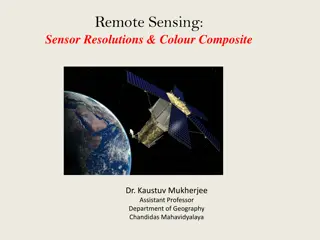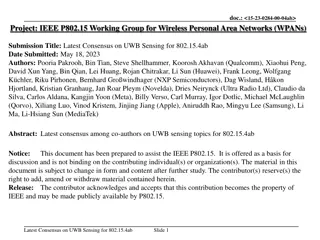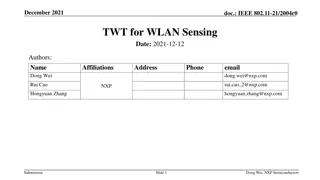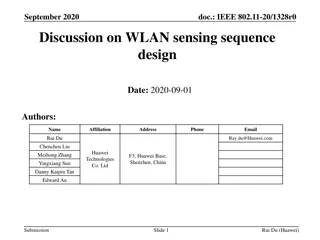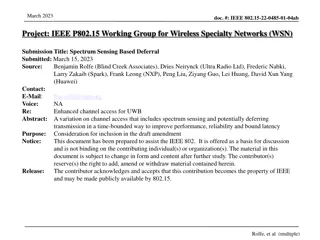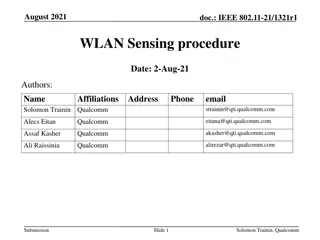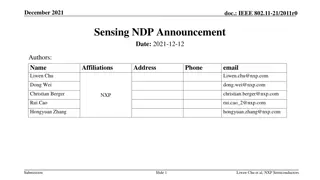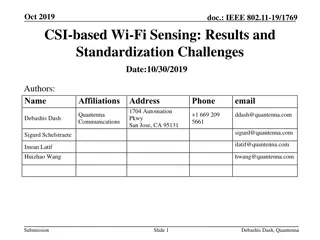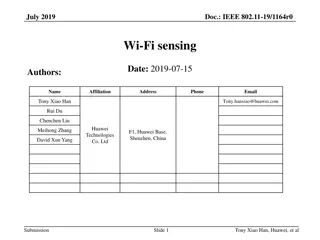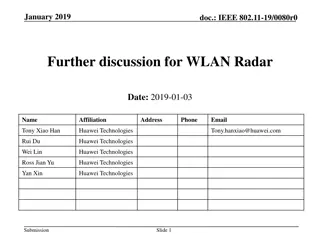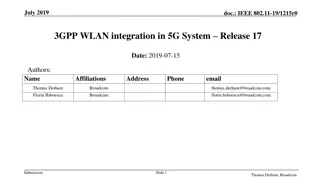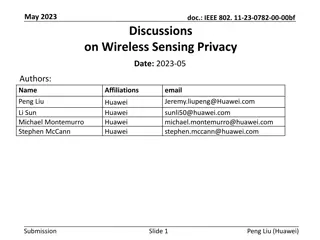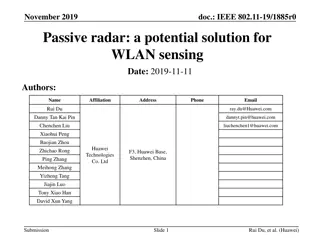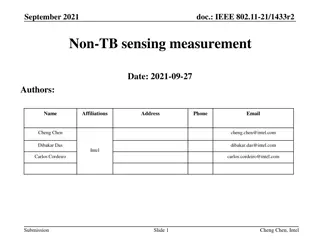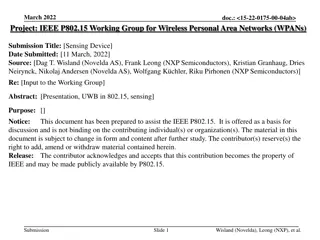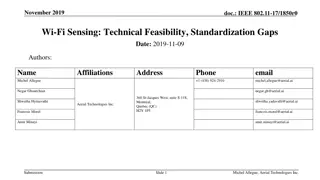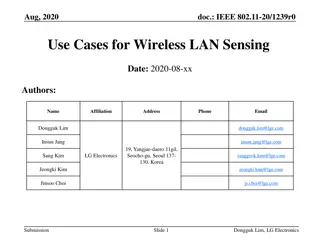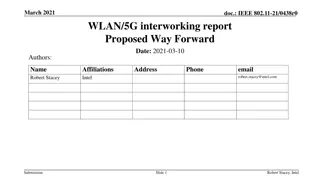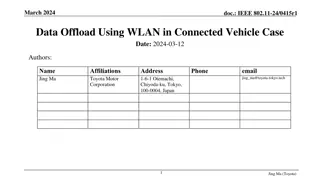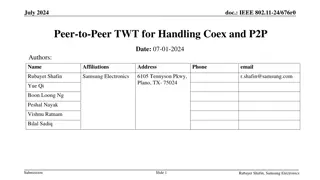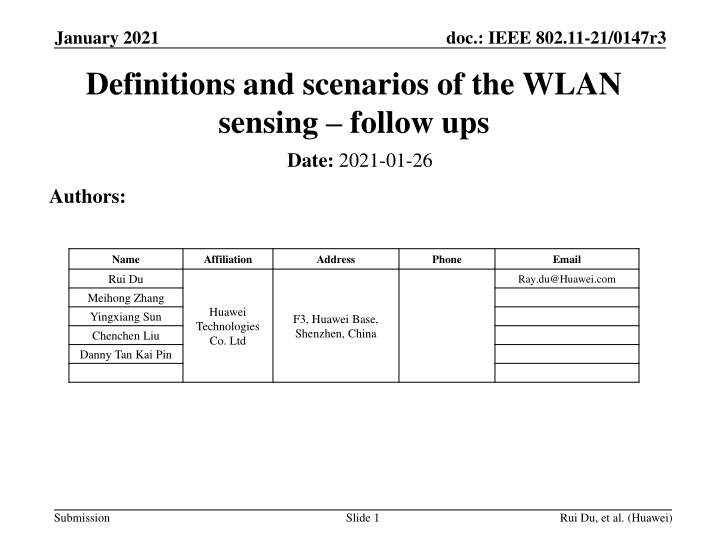
WLAN Sensing Definitions and Scenarios Overview
Explore the detailed discussion on WLAN sensing definitions, roles, related terms, and scenarios in the IEEE 802.11-21/0147r3 document from January 2021 by Huawei. The contribution focuses on various aspects such as the roles of different devices in WLAN sensing, signal processing, measurement results, and more.
Download Presentation

Please find below an Image/Link to download the presentation.
The content on the website is provided AS IS for your information and personal use only. It may not be sold, licensed, or shared on other websites without obtaining consent from the author. If you encounter any issues during the download, it is possible that the publisher has removed the file from their server.
You are allowed to download the files provided on this website for personal or commercial use, subject to the condition that they are used lawfully. All files are the property of their respective owners.
The content on the website is provided AS IS for your information and personal use only. It may not be sold, licensed, or shared on other websites without obtaining consent from the author.
E N D
Presentation Transcript
January 2021 doc.: IEEE 802.11-21/0147r3 Definitions and scenarios of the WLAN sensing follow ups Date: 2021-01-26 Authors: Name Affiliation Address Phone Email Rui Du Ray.du@Huawei.com Meihong Zhang Yingxiang Sun Chenchen Liu Danny Tan Kai Pin Huawei Technologies Co. Ltd F3, Huawei Base, Shenzhen, China Submission Slide 1 Rui Du, et al. (Huawei)
January 2021 doc.: IEEE 802.11-21/0147r3 Outline Abstract Definitions of WLAN sensing Roles of WLAN sensing Related terms in WLAN sensing Sensing session Sensing types Scenarios of WLAN sensing Summary References Submission Slide 2 Rui Du, et al. (Huawei)
January 2021 doc.: IEEE 802.11-21/0147r3 Abstract WLAN sensing definitions and scenarios have been discussed in previous contributions[1-6]. Based on the discussion on our previous contribution[6], a follow up contribution is shown. In this contribution, some of the typical WLAN sensing scenarios proposed in [6] are further introduced and discussed. Submission Slide 3 Rui Du, et al. (Huawei)
January 2021 doc.: IEEE 802.11-21/0147r3 Definition of roles in WLAN sensing Roles in the WLAN sensing Sensing initiator Device who initiates the sensing session and wants the sensing results. It is not mandatory for the sensing initiator to participate in the sensing measurement or processing. If sensing initiator also is sensing transmitter or receiver, it is a non-standalone initiator. If sensing initiator is neither sensing transmitter nor receiver, it is a standalone initiator. Sensing responder Non-initiator device who participates in the sensing session. Sensing transmitter Device who transmits sensing illumination signal to illuminate the area of interest. Sensing receiver Device who receives echo signal and measure the area of interest. Sensing processor Device who processes the sensing measurements and gets sensing result. Sensing processor could be the same device with sensing initiator, which means sensing measurements are processed at sensing initiator. Sensing processor also could be different device with sensing initiator(could be sensing transmitter and/or receiver), which means sensing measurements are processed and the sensing results are further feedback to sensing initiator. During the sensing session, there could be more than one sensing processor. Note: the roles discussed here are functions rather than fixed roles of stations. Submission Slide 4 Rui Du, et al. (Huawei)
January 2021 doc.: IEEE 802.11-21/0147r3 Definition of related terms in WLAN sensing Signals in the WLAN sensing Illumination signal The illumination signal is transmitted by a sensing transmitter to illuminate the area of interest. The illumination signal could be non-dedicated illumination signal in the environment(un- coordinated or passive mode). Echo signal The echo signal is the signal received at the sensing receiver which contains the information of the area of interest. Measurement result in the WLAN sensing Sensing measurement The sensing measurement is the measurement of the area of interest e.g. raw CSI, received radar signal . Sensing result The sensing result is the result after signal processing at the sensing processor(e.g. compressed CSI, range-Doppler map, range-time map). Submission Slide 5 Rui Du, et al. (Huawei)
January 2021 doc.: IEEE 802.11-21/0147r3 Definition of sensing session Three phases are defined as follows. Negotiation phase During the negotiation phase, initiator negotiates with the station who will participate in the sensing session and identifies the transmitter, receiver and processer. Measurement phase During the measurement phase, sensing transmitter transmits the illumination signal to illuminate the area of interest, sensing receiver receives the echo signal to measure the area of interest. Feedback phase(if needed) During the feedback phase, two kinds of information could be feedback to the initiator. If the sensing initiator also is the sensing processor, sensing measurement(s) will be feedback to the initiator and processed to get the sensing result. If the sensing initiator is not the sensing processor, sensing measurement(s) will be sent to the sensing processor and the sensing result will be reported to sensing initiator. Submission Slide 6 Rui Du, et al. (Huawei)
January 2021 doc.: IEEE 802.11-21/0147r3 Definitions of sensing types CSI based sensing Radar based sensing The transmitter and receiver do not need to be synchronized. The transmitter and receiver are usually synchronized (usually ask for much higher synchronization performance than wireless communication, e.g. STF ). Coordinated Sensing transmitter(s) will be involved in the sensing session and would transmit illumination signal to illuminate the area of interest. The sensing receiver receives the echo signal to measure the area of interest. Un-coordinated There is no dedicated sensing transmitter involved in the sensing session and the sensing receiver measures the area of interest by receiving the illumination signal in the environment. Active radar (coordinated) Sensing transmitter(s) will be involved in the sensing session and would transmit illumination signal to illuminate the area of interest. The sensing receiver receives the echo signal to measure the area. There could be different geometries for active radar, e.g. Monostatic radar Bistatic radar Multistatic radar Passive radar (un-coordinated) There is no dedicated sensing transmitter involved in the sensing session and the sensing receiver measures the area of interest by receiving the illumination signal in the environment. Although the transmitter and receiver are not synchronized in the passive radar, the reference signal channel and echo signal channel at the receiver are synchronized. Submission Slide 7 Rui Du, et al. (Huawei)
January 2021 doc.: IEEE 802.11-21/0147r3 Scenarios of WLAN sensing Scenarios of WLAN sensing CSI based sensing Radar based sensing 1 2 3 4 Un-coordinated CSI based sensing Coordinated CSI based sensing Active radar Passive radar 3-1 1-2 1-3 3-2 3-3 1-1 Multi transmitters or multi receivers, participators are transmitters or receivers Multi transmitters or multi receivers, participators are transmitters and receivers One transmitter and one receiver One monostatic radar Multi monostatic radars Bistatic/multistatic radars The scenarios of WLAN sensing are quite complicated and we classify them into different categories. Each individual scenario is further discussed in the following slides. Submission Slide 8 Rui Du, et al. (Huawei)
January 2021 doc.: IEEE 802.11-21/0147r3 Scenarios of WLAN sensing 1-1 Coordinated CSI based sensing(one transmitter and one receiver) Sensing initiator(non- standalone) Sensing receiver Sensing processor Sensing initiator(non- standalone) Sensing transmitter Sensing receiver STA2 STA1 STA1 Illumination signal Sensing measurement STA1 Sensing result Sensing initiator(standalone) Sensing processor STA3 STA2 STA2 Sensing transmitter Sensing receiver Sensing processor Sensing transmitter Left figure: STA1 is the sensing initiator(non-standalone initiator) and sensing receiver, STA2 is the sensing transmitter. STA1 initiates the sensing session, STA2 transmits the illumination signal and STA1 receives the echo signal to measure the area of interest. The echo signal received at STA1 could be processed to get the desired information. Middle figure STA1 is the sensing initiator(non-standalone initiator) and sensing transmitter, STA2 is the sensing receiver. STA1 initiates the sensing session, transmits the illumination signal and STA2 receives the echo signal to measure the area of interest. Sensing measurement or result could be fed back to sensing initiator (STA1) as request. Right figure STA1 is the sensing initiator(standalone initiator), STA3 is the sensing transmitter, STA2 is the sensing receiver. STA1 initiates the sensing session, STA3 transmits the illumination signal and STA2 receives the echo signal to measure the area of interest. Sensing measurement or result could be reported to sensing initiator (STA1) as request. Submission Slide 9 Rui Du, et al. (Huawei)
January 2021 doc.: IEEE 802.11-21/0147r3 Scenarios of WLAN sensing 1-2/3 Coordinated CSI based sensing(multi transmitter or multi receiver, participators are transmitters or receivers) Sensing initiator(non- standalone) Sensing transmitter Sensing processer Sensing initiator(non- standalone) Sensing receiver Sensing processor Sensing receiver Sensing processor STA1 STA1 STA2 Illumination signal Sensing measurement STA1 Sensing result Sensing initiator(standalone) STA2 STA3 STA2 STA3 STA3 STA4 Sensing transmitter Sensing transmitter Sensing receiver Sensing receiver Sensing transmitter Sensing transmitter Left figure: STA1 is the sensing initiator(non-standalone initiator) and sensing receiver, STA2/STA3 are the sensing transmitters. STA1 initiates sensing session, STA2/STA3 transmit the illumination signal and STA1 receives the echo signal to measure the area of interest. The echo signals received at STA1 could be processed to get the desired information. Middle figure STA1 is the sensing initiator(non-standalone initiator) and sensing transmitter, STA2/STA3 are the sensing receivers. STA1 initiates sensing session, transmits the illumination signal and STA2/STA3 receive the echo signals to measure the area of interest. Sensing measurement or result could be fed back to sensing initiator (STA1) as request. Right figure STA1 is the sensing initiator(standalone initiator), STA3/STA4 are the sensing transmitters, STA2 is the sensing receiver. STA1 initiates sensing session, STA3/SAT4 transmit the illumination signals and STA2 receives the echo signals to measure the area of interest. Sensing measurement or result could be reported to sensing initiator (STA1) as request. Submission Slide 10 Rui Du, et al. (Huawei)
January 2021 doc.: IEEE 802.11-21/0147r3 Scenarios of WLAN sensing 2 Un-coordinated CSI based sensing STA1 STA2 STA1 STA2 STA1 STA2 Communication signal Sensing measurement Sensing result STA3 STA4 STA3 STA4 STA3 Sensing receiver Sensing Sensing initiator(non- standalone) Sensing receiver Sensing processor Sensing initiator(non- standalone) Sensing receiver Sensing processor Sensing receiver Sensing processor initiator(standalone) Left figure: STA1 and STA2 are communicating. STA3 is the sensing initiator(non-standalone), sensing receiver and sensing processor. STA3 receives the echo signal to measure the area of interest. The echo signals received at STA1 could be processed to get the desired information. Middle figure STA1 and STA2 are communicating. STA3 is the sensing initiator(standalone initiator), STA4 is the sensing receiver and sensing processor. STA4 receives the echo signal to measure the area of interest. Sensing measurement or result could be reported to sensing initiator (STA3) as request. Right figure STA1 and STA2 are communicating. STA3 is the sensing initiator(non-standalone initiator), sensing receiver and sensing processor, STA4 is the sensing receiver. Sensing measurement or result could be reported to sensing initiator (STA3) as request. Submission Slide 11 Rui Du, et al. (Huawei)
January 2021 doc.: IEEE 802.11-21/0147r3 Scenarios of WLAN sensing 3-1 Active radar sensing(one monostatic radar) STA1 Illumination signal Sensing Illumination signal Echo signal initiator(standalone) Echo signal Sensing measurement Sensing result STA1 STA2 Sensing initiator(non- standalone) Sensing transmitter Sensing receiver Sensing processer Sensing transmitter Sensing receiver Sensing processor Left figure: STA1 is the sensing initiator(non-standalone initiator), sensing transmitter, sensing receiver and sensing processor. STA1 initiates sensing session, transmits the illumination signal and receives the echo signal to measure the area of interest. The echo signals received at STA1 could be processed to get the desired information. Right figure STA1 is the sensing initiator(standalone initiator), STA2 is the sensing transmitter, sensing receiver and sensing processor. STA1 initiates sensing session, STA3/SAT4 transmit the illumination signals and STA2 receives the echo signals to measure the area of interest. Sensing measurement or result could be reported to sensing initiator (STA1) as request. Submission Slide 12 Rui Du, et al. (Huawei)
January 2021 doc.: IEEE 802.11-21/0147r3 Scenarios of WLAN sensing 3-2 Active radar sensing(multi monostatic radars) Illumination signal Echo signal STA1 Sensing measurement Sensing Sensing result initiator(standalone) Sensing processor STA1 STA2 STA2 STA3 Sensing initiator(non- standalone) Sensing transmitter Sensing receiver Sensing processor Sensing transmitter Sensing receiver Sensing transmitter Sensing receiver Sensing transmitter Sensing receiver Left figure: STA1 is the sensing initiator(non-standalone initiator), sensing transmitter, sensing receiver and sensing processor, STA2 is the sensing transmitter and sensing receiver. STA1 initiates sensing session, STA1/2 transmit the illumination signals and receive the echo signals to measure the area of interest. The echo signals received at STA2 could be sent to STA1 as request. Right figure STA1 is the sensing initiator(standalone initiator), STA2/3 are the sensing transmitters, sensing receivers. STA1 initiates sensing session, STA2/SAT3 transmit the illumination signals and STA2 receive the echo signals to measure the area of interest. Sensing measurement or result could be reported to sensing initiator (STA1) as request. Submission Slide 13 Rui Du, et al. (Huawei)
January 2021 doc.: IEEE 802.11-21/0147r3 Scenarios of WLAN sensing 3-3 Bistatic/multistatic radar sensing Bistatic/multistatic radar sensing scenarios are similar with the scenarios have been shown in slide 9/10. Submission Slide 14 Rui Du, et al. (Huawei)
January 2021 doc.: IEEE 802.11-21/0147r3 Scenarios of WLAN sensing 4 Passive radar sensing Passive radar sensing scenarios are similar with the scenarios have been shown in slide 11. Submission Slide 15 Rui Du, et al. (Huawei)
January 2021 doc.: IEEE 802.11-21/0147r3 Summary In this contribution, relevant basic definitions of WLAN sensing are shown and discussed. Details of some typical scenarios of WLAN sensing are presented and discussed. Submission Slide 16 Rui Du, et al. (Huawei)
January 2021 doc.: IEEE 802.11-21/0147r3 References [1] 11-20-1849-01-00bf-wi-fi-sensing-definitions.pptx [2] 11-20-1850-00-00bf-overview-of-wi-fi-sensing-scenarios.pptx [3] 11-20-1805-00-00bf-discussion-on-wlan-sensing-roles.pptx [4] 11-20-1804-00-00bf-discussion-on-wlan-sensing-procedure.pptx [5] 11-20-1960-00-00bf-analysis-of-the-functionality-of-sensing.pptx [6] 11-21-0035-00-00bf-definitions-and-scenarios-of-the-wlan- sensing.pptx Submission Slide 17 Rui Du, et al. (Huawei)
January 2021 doc.: IEEE 802.11-21/0147r3 SP 1 Do you agree with the following? A sensing initiator might be neither a sensing transmitter nor a sensing receiver. Submission Slide 18 Rui Du, et al. (Huawei)
January 2021 doc.: IEEE 802.11-21/0147r3 SP 2 Do you agree with the following? Results of measurement performed in a sensing session should be obtained by or reported to its initiator. Submission Slide 19 Rui Du, et al. (Huawei)
January 2021 doc.: IEEE 802.11-21/0147r3 SP 3 Do you agree with the following? The 11bf amendment may define more than one type of sensing measurement results. Submission Slide 20 Rui Du, et al. (Huawei)
January 2021 doc.: IEEE 802.11-21/0147r3 SP 4 Do you agree with the following? The type of measurement result obtained in a sensing session shall be deci ded by its initiator. Submission Slide 21 Rui Du, et al. (Huawei)

